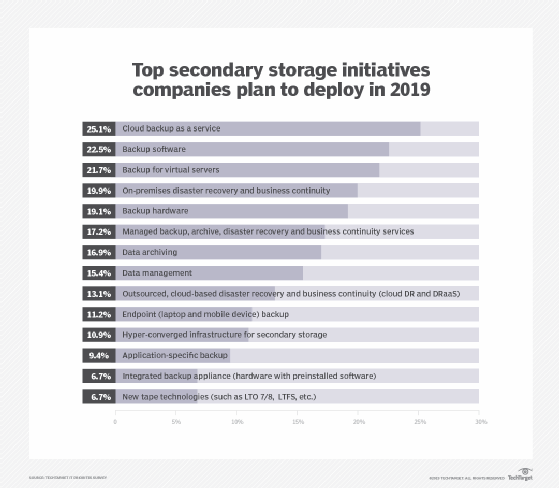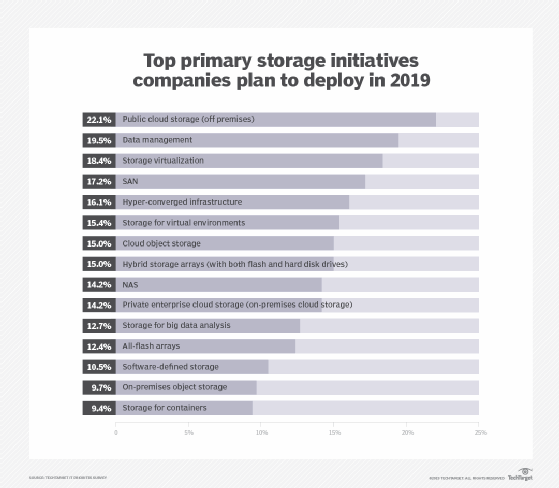
ra2 studio - Fotolia
Cloud, data management top 2019 enterprise data storage options
Data management -- on premises and in the cloud -- appears on the rise as a 2019 spending priority for storage pros, while flash arrays and converged infrastructure may have peaked.
Public cloud and data management will be the top IT storage initiatives in 2019. Object storage and storage for big data analysis and containers are growing priorities, while fewer IT professionals plan to spend on flash, converged infrastructure and backup software.
That's what TechTarget's annual IT Priorities survey showed heading into 2019. Of the 267 IT pros who responded to questions about enterprise data storage options, 22.1% said they would deploy off-premises cloud storage in 2019, and 19.5% plan to make data management a priority.
Data management is becoming critical for IT organizations that adopt hybrid cloud storage strategies that span on-site systems and off-premises clouds, such as AWS and Microsoft Azure. Organizations face mounting challenges with regulatory compliance and data privacy requirements, such as Europe's General Data Protection Regulation.
Still, plenty of IT teams have no plans to use public cloud storage in 2019 for primary or secondary storage. Close to 20% of the 267 IT pros who work with enterprise data storage said they don't use public cloud storage services. Another 17.6% use off-premises cloud services to store less than 10 TB of data, and 11.2% store 10 TB to 99 TB.
At the other extreme, about 13% of the respondents store 1 PB or more in off-premises cloud services for primary and secondary storage, including backup and disaster recovery.
Cloud use in secondary storage
Cloud backup as a service is the top priority for secondary storage in 2019, cited by 25.1% of the 267 survey respondents. More than 20% also picked backup software and backup for virtual servers as secondary enterprise data storage priorities, although the percentages decreased since 2018 for those options.
In TechTarget's 2018 IT Priorities survey, 24.4% of the 164 IT pros who answered storage questions said they would spend on backup software, and 32.3% planned to deploy backup for virtual servers.
Backup for virtual servers wasn't the only data protection option to drop more than 10 percentage points from 2018 to 2019. Endpoint backup of laptops and mobile devices dropped from 21.3% to 11.2%, and application-specific backup fell from 22% to 9.4%.

Rising IT priorities in 2019
Cloud-based and on-premises object stores and storage for big-data analysis and containers are among the enterprise data storage options that will become higher priorities in 2019.
In the 2019 IT Priorities survey, 15% of the storage respondents said they would deploy public cloud object storage, such as Amazon's Simple Storage Service or Microsoft's Azure Blob Storage. Also, close to 10% indicated they would implement on-premises object storage, up from 4.9% a year ago.
Disk-based object storage can help IT organizations cope with the explosive growth of unstructured primary data, and it can provide an alternative to traditional tape-based backup and archives. Key advantages of object storage include the ability to scale out across standard x86 servers to reduce costs and provide greater flexibility to add capacity when necessary.
According to TechTarget's IT Priorities survey of enterprise data storage options, storage deployments linked to big data analysis will rise from 9.8% to 12.7% in 2019. Storage initiatives for containers will increase from 4.9% to 9.4%. A wide range of options can address those use cases, including cloud-based block and object storage, on-premises software-defined storage and flash storage.
Primary enterprise data storage options
On the primary storage side, converged infrastructure, all-flash arrays and hybrid arrays that mix flash and slower hard disk drives all fell significantly as priorities between 2018 and 2019.
Only 12.4% of the 2019 survey respondents said they would have a primary storage initiative involving all-flash arrays. That's less than half of the 25% that cited all-flash arrays as a 2018 priority. Hybrid storage arrays fell from 25% in 2018 to 15% in 2019.
Marc Staimer, president of Dragon Slayer Consulting, said sales of all-flash arrays shot up in 2018, and because customers tend to keep them for at least a few years, their growth could be incremental in 2019. IT organizations may not be inclined to spend money on the next generation of flash storage if they're getting adequate performance from their existing products, Staimer said.
"Also, the economy's slowing down worldwide," he added. "Capital investment is going to be down this year across the board."
Still, overall IT budgets seem to be increasing in 2019. More than half (55.3%) of the 354 IT pros that responded to a question on budget expectations for 2019 versus 2018 indicated their budgets would increase, and another 20.3% said their budgets would remain the same. Only 5.9% anticipated a budget decrease, although 18.4% were unsure.

Converged and hyper-converged infrastructure
The outlook for converged infrastructure looks even worse than for all-flash and hybrid arrays in TechTarget's 2019 IT Priorities survey. In 2018, 20.7% of respondents said they would deploy converged infrastructure for primary storage, but only 7.1% are planning initiatives in 2019.
Hyper-converged infrastructure (HCI) for primary storage declined slightly, from 21.3% in 2018 to 16.1% in 2019. HCI aggregates various components, including compute, virtualization, storage and networking, in the same box, whereas converged infrastructure combines discrete storage, compute and networking resources in a single rack.
Virtualization will remain a key technology for primary storage. The 2019 survey of enterprise data storage options showed that 18% of respondents plan to deploy storage virtualization to pool disparate systems and manage them through a central console. That's the same percentage that cited storage virtualization in 2018.







